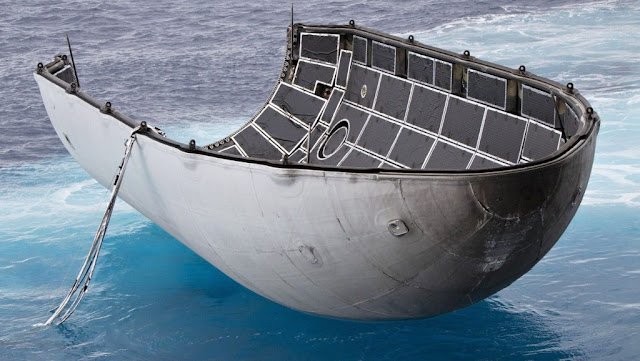Everyone knows the quote attributed to Ian Fleming, "Once is happenstance. Twice is coincidence. Three times is enemy action." In this case all three are design decisions.
If all goes as scheduled, at 9:57 PM EST Monday night, SpaceX will launch the Eutelsat 10B geostationary communications satellite. What's the 1-2-3? In a rare coincidence, Eutelsat 10B will be SpaceX’s second expendable Falcon 9 launch in a row and the third Falcon launch to expend a booster this month - the first being the Falcon Heavy launch that started the month.
The Falcon 9 user's guide has always said that there were missions from which recycling a booster wasn't possible. Because of that, those missions are more expensive. All of these three missions are that sort of profile. The Falcon Heavy mission recovered the two strap-on boosters but the center core "gave its all" to achieve the desired orbit. The other mission they refer to was the Intelsat Galaxy 31 & 32 mission last week, which said it needed to expend the booster to achieve its geostationary orbit transfer trajectory. That appears to be the case for Eutelsat 10B as well, although Eric Ralph at Teslarati phrases it this way:
For unknown reasons, the French communications provider paid extra to get as much performance as possible out of Falcon 9, requiring SpaceX to expend the rocket’s booster instead of attempting to land and reuse it.
Although landing the booster and reusing it is the spectacular aspect of Falcon 9 flights, gathering the most attention, there are other recoveries, too and that will be in operation for tonight's launch. (As an aside, booster 1049 to be disposed of on this mission is the oldest block 5 booster in the system; on it's 10th flight, it's well behind the 14th flight of the current leaders.)
We're talking, of course, about recovering the payload fairings that surround the payload satellites through the densest part of the atmosphere. Along with the booster recoveries, SpaceX has also managed to become the first launch entity in the world to successfully recover and reuse the fairings.
There have been 52 Falcon launches so far this year. Of those, four were
variants of the Dragon capsule that doesn't use fairings at all. Of the
48 that flew with fairings, 40 have launched with at least one reused fairing
half. Elon Musk at one time gave a rough estimate of 10% of the cost of
a new Falcon 9 being in the fairings. Given the (approximate) cost of
the Falcon 9, that means the complete fairing costs in range of 6.2 to $6.7
million. Would you spend some money to go catch $6.2 million? The
question is how cost effectively you can do it.
You might recall the early attempts to recover fairings were based on catching the fairings in mid-air with huge nets above boats (Ms. Tree and Ms. Chief). Given the success to effort ratio, they eventually decided to seal everything better so the saltwater immersion isn't as threatening and fish the fairing halves out of the water. Waterproofing instead of catching them with big nets.
A Falcon 9 fairing half floats on the Pacific in 2018. SpaceX Photo
Eric Ralph's notes on distances offshore for this and other fairing recovery missions are a bit tough to understand. One Tweet points out that Recovery ship Doug is roughly 550 nautical miles downrange, in position for tonight's launch. A few paragraphs later he says Eutelsat is, "Aiming for a region 1015 kilometers (630 mi) downrange," says that may be a record, but in the previous paragraph about November 1st's Falcon Heavy flight says,
Despite the booster’s disposal and record-smashing speed at main engine cut-off (MECO; 4 km/s or 8900 mph), SpaceX still managed to recover both of Falcon Heavy’s hypersonic fairing halves after they reentered Earth’s atmosphere and splashed down in the Atlantic Ocean almost 1500 kilometers (~930 mi) downrange. Eleven days later, SpaceX expended a Falcon 9 rocket to launch two Intelsat communications satellites. Once again, both fairing halves were recovered – this time around 960 kilometers (598 mi) downrange.
I guess when he says 630 miles downrange is a record, he means for something launched as a Falcon 9, while the 930 miles is for the center rocket in a Falcon Heavy.
And with an hour to go before the launch, tonight's Eutelsat 10B launch has been scrubbed and reset for Tuesday night. At the moment, that implies that tomorrow afternoon's 3:54 PM, CRS-26 launch to the ISS from pad 39A will be about six hours before the Eutelsat launch from SLC-40.

The expendable booster explains why so many DOD missions are so expensive in comparison to normal satellite launches.
ReplyDeleteReally looking forward to the total reuseable Starship.
Excellent news! I love how this is making space travel routine.
ReplyDeleteI heard on the SpaceX "channel" that CRS-26 had been re-scheduled for Saturday.
ReplyDeleteWe were under ridiculous amounts of rain all day, so I assumed it would be. The scrub notice went up not long ago.
DeleteThe Eutelsat mission coverage still says, "live in XXX minutes at 9:45 PM" so it apparently hasn't been scrubbed, yet.
Just watched the video coverage. Didn't try to go outside, but could hear the launch rumble once the sound made it here. Always worth watching.
Delete